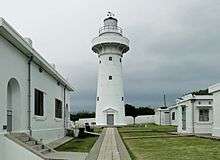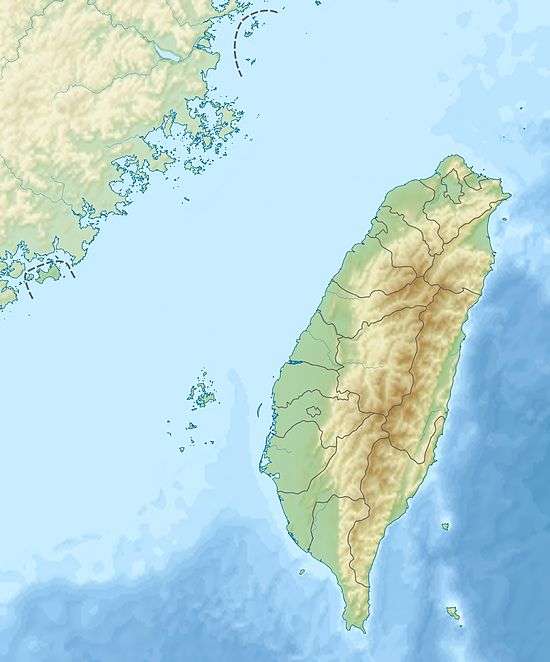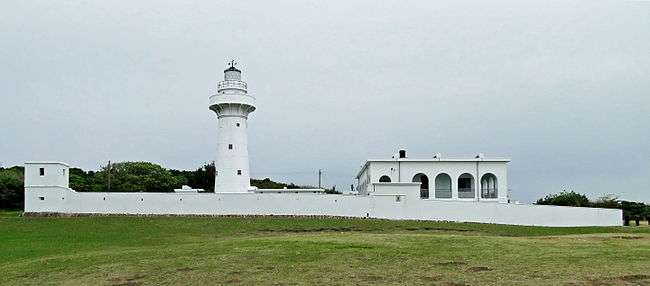Eluanbi Lighthouse
 Eluanbi Lighthouse | |
 Taiwan | |
| Location |
Eluanbi Hengchun Pingtung County Taiwan |
|---|---|
| Coordinates | 21°54′08″N 120°51′09″E / 21.902282°N 120.852622°ECoordinates: 21°54′08″N 120°51′09″E / 21.902282°N 120.852622°E |
| Year first constructed | 1882 |
| Foundation | concrete and granite |
| Construction | cast iron tower |
| Tower shape | cylindrical tower with balcony and lantern |
| Markings / pattern | white tower, black lantern dome |
| Height | 21.4 m (70 ft) (five floors) |
| Focal height | 56.4 m (185 ft) |
| Original lens | Fourth order fresnel |
| Intensity | 1,800,000 candela |
| Range | 27.2 nautical miles (50.4 km; 31.3 mi) |
| Characteristic | Fl W 10s. |
| Admiralty number | P4602 |
| NGA number | 13768 |
| ARLHS number | TAI-018 |
| Managing agent |
Kenting National Park[1] [2] |
Eluanbi Lighthouse (Chinese: 鵝鑾鼻燈塔; pinyin: Éluánbí Dēngtǎ) is a lighthouse located on Cape Eluanbi, the southernmost point of Taiwan, to the south of Hengchun in Pingtung County, Taiwan. Eluanbi Lighthouse is managed by the Customs Administration, Ministry of Finance, Taiwan. The lighthouse is built between the Pacific Ocean and the Taiwan Strait, facing toward the Luzon Strait. Thus, the lighthouse has a splendid panorama. The lighthouse is open to the public all year around. Today, Eluanbi Lighthouse is called "The Light of East Asia", because its intensity is the most powerful among Taiwan lighthouses.
History
Qing dynasty
Eluanbi Lighthouse was built during the Qing Dynasty in 1883. Accidents in the area such as the Rover Incident were quite frequent due to the hidden reefs. An English architect W. F. Spindey, a member of Royal Geographical Society, was hired to construct this lighthouse as a guide for nearby ships. The lighthouse is the only armed lighthouse in the world, with a trench surrounding it and many gun holes on the wall. The extra fortifications were required at the time it was built because of frequent raids by local aboriginal tribes.
Japanese rule period
Per the Treaty of Shimonoseki, Taiwan became a colony of the Empire of Japan. Severe damage suffered during the First Sino-Japanese War was repaired in 1898 during Japanese rule. However, during World War II, the lighthouse was again seriously damaged by Allied bombing during the Aerial Battle of Taiwan-Okinawa.
Present
In 1962, the lighthouse was re-built as a conical concrete building with a white cover. Today, the lighthouse is still functional and is also held as a historical monument admired by many tourists in the Kenting National Park. In addition, next to the lighthouse there is an Eluanbi Memorial (see Gallery) of Taiwan Eight Magnificent Sceneries. On the memorial the Chinese "Eluanbi" (Chinese: 鵞鑾鼻) is sculptured on the surface, written in Wang Xizhi's calligraphy style.

See also
References
- ↑ Eluanbi The Lighthouse Directory. University of North Carolina at Chapel Hill. Retrieved April 13, 2016
- ↑ Eluan Pi Lighthouse Maritime and Port Bureau
- Su-fang Li, "The Lighthouses in Taiwan", Yuan-zu Culture Publ. Inc., Taipei county, Taiwan, 2002, pp. 126-131. ISBN 957-28031-2-3 (in Chinese)
- Lun-hui Yue, "Ocean Navigator-The Fair of Taiwan Lighthouses", Kaohsiung History Museum, Kaohsiung, 2000, pp. 83-86. ISBN 957-02-7455-7 (in Chinese)
- Customs, Ministry of Finance of Taiwan, "The Concise History of the Republic of China Customs", Taipei, 1998. ISBN 957-00-4861-1 (in Chinese)
External links
| Wikimedia Commons has media related to Eluanbi Lighthouse. |
- Kenting National Park(Taiwan) (in English)(in Japanese)(in Chinese)
- Eluanbi Lighthouse-Directorate General of Customs(Taiwan) (in English)(in Chinese)
- Eluanbi Lighthouse(Taiwan) (in Chinese)
- Maritime and Port Bureau MOTC
